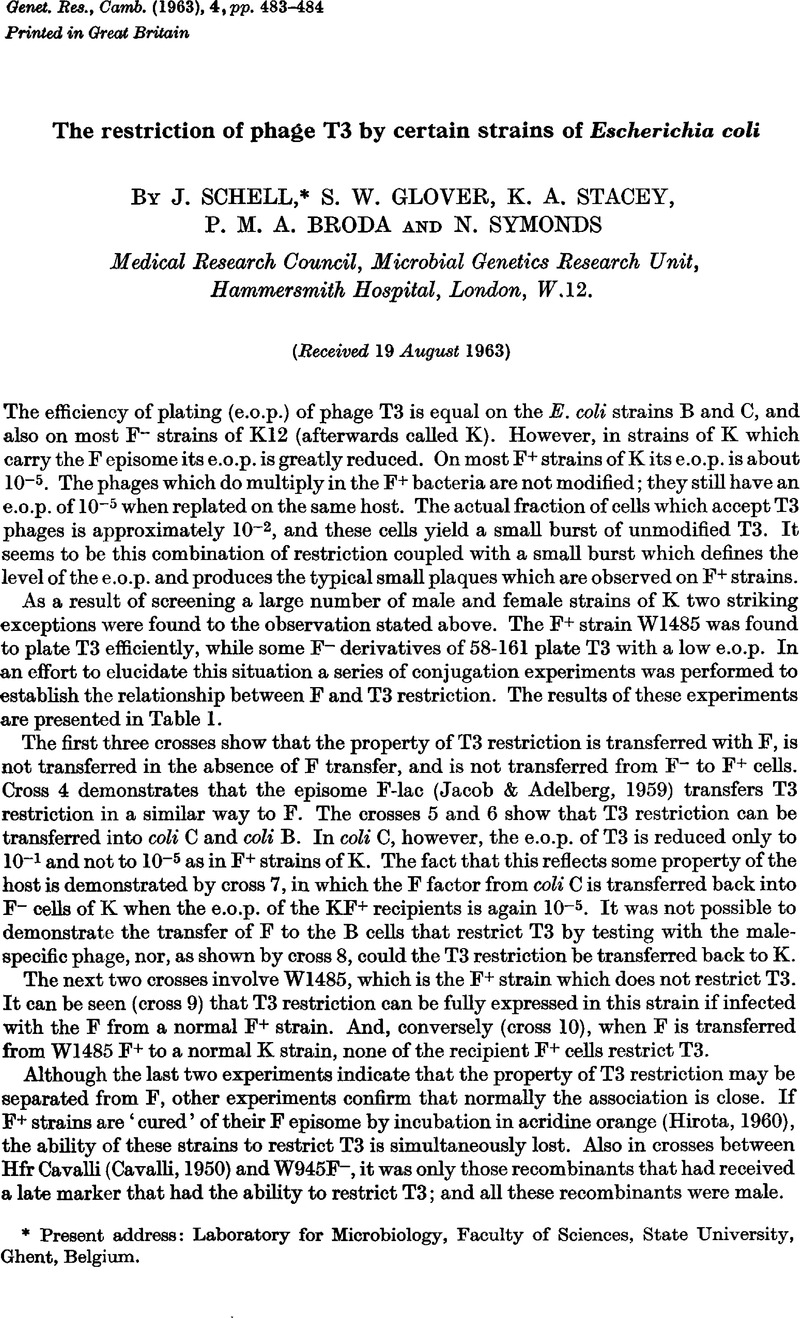Crossref Citations
This article has been cited by the following publications. This list is generated based on data provided by Crossref.
Klein, A.
1965.
Wirtskontrollierte Modifikation.
Zeitschrift f�r Vererbungslehre,
Vol. 96,
Issue. 4,
p.
324.
Klein, Albrecht
and
Sauerbier, Walter
1965.
Role of methylation in host controlled modification of phage T1.
Biochemical and Biophysical Research Communications,
Vol. 18,
Issue. 3,
p.
440.
Meynell, Elinor
and
Datta, Naomi
1966.
The nature and incidence of conjugation factors inEscherichia coli.
Genetical Research,
Vol. 7,
Issue. 1,
p.
141.
Eskridge, Rosemary W.
Weinfeld, Herbert
and
Paigen, Kenneth
1967.
Susceptibility of Different Coliphage Genomes to Host-controlled Variation.
Journal of Bacteriology,
Vol. 93,
Issue. 3,
p.
835.
Meynell, E
Meynell, G G
and
Datta, N
1968.
Phylogenetic relationships of drug-resistance factors and other transmissible bacterial plasmids.
Bacteriological Reviews,
Vol. 32,
Issue. 1,
p.
55.
Novick, R P
1969.
Extrachromosomal inheritance in bacteria.
Bacteriological Reviews,
Vol. 33,
Issue. 2,
p.
210.
Cooke, Marylyn
and
Meynell, Elinor
1969.
Chromosomal transfer mediated by de-repressed R factors in F−Escherichia coliK 12.
Genetical Research,
Vol. 14,
Issue. 1,
p.
79.
Frydman, Anna
and
Meynell, Elinor
1969.
Interactions between de-repressed F-like R factors and wild type Colicin B factors: superinfection immunity and represser susceptibility.
Genetical Research,
Vol. 14,
Issue. 3,
p.
315.
Romero, E.
and
Meynell, Elinor
1969.
Covert
fi
−
R Factors in
fi
−
R
+
Strains of Bacteria
.
Journal of Bacteriology,
Vol. 97,
Issue. 2,
p.
780.
Schell, Jozef
1969.
The mechanism of restriction of bacteriophage λ in Escherichia coli strains: Demonstration of an in vivo requirement for S-adenosylmethionine.
Virology,
Vol. 39,
Issue. 1,
p.
66.
Groman, Neal B.
1969.
Restriction of bacteriophage φX174 by F factor.
Biochemical and Biophysical Research Communications,
Vol. 37,
Issue. 4,
p.
691.
Frydman, Anna
Cooke, Marylyn
Meynell, Elinor
and
Meynell, G.G.
1970.
Repressor-insensitive mutants of the F sex factor.
Journal of Molecular Biology,
Vol. 48,
Issue. 1,
p.
177.
Cooke, Marylyn
Meynell, Elinor
and
Lawn, A. M.
1970.
Mutant Hfr strains defective in transfer: restoration by F-like and I-like de-repressed R factors.
Genetical Research,
Vol. 16,
Issue. 1,
p.
101.
Siersma, P. W.
and
Lederberg, S.
1970.
In Vivo Suppression of Coding Associated with Bacteriophage-Induced
S
-Adenosylmethionine Hydrolase
.
Journal of Bacteriology,
Vol. 101,
Issue. 2,
p.
398.
MORRISON, TRUDY G.
and
MALAMY, MICHAEL H.
1971.
T7 Translational Control Mechanisms and their Inhibition by F Factors.
Nature New Biology,
Vol. 231,
Issue. 19,
p.
37.
Williams, Lesley
and
Meynell, G. G.
1971.
Female-specific phages and F-minus strains of Escherichia coli K12.
Molecular and General Genetics MGG,
Vol. 113,
Issue. 3,
p.
222.
Glover, S. W.
1972.
Bacterial Plasmids and Antibiotic Resistance.
p.
179.
Ippen-Ihler, K.
Achtman, M.
and
Willetts, N.
1972.
Deletion Map of the
Escherichia coli
K-12 Sex Factor F: the Order of Eleven Transfer Cistrons
.
Journal of Bacteriology,
Vol. 110,
Issue. 3,
p.
857.
Skurray, Ronald A.
and
Reeves, Peter
1973.
Characterization of Lethal Zygosis Associated with Conjugation in
Escherichia coli
K-12
.
Journal of Bacteriology,
Vol. 113,
Issue. 1,
p.
58.
Schweiger, Manfred
and
Herrlich, Peter
1974.
Modern Aspects of Electrochemistry.
Vol. 18,
Issue. ,
p.
59.





